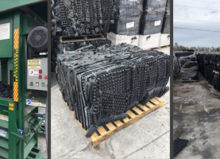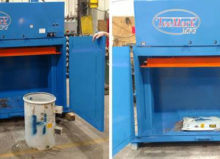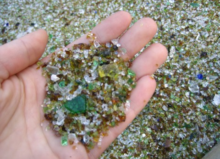To Compact or Bale, That is the Question
What is the difference between a Compactor and a Baler?
Waste management consists of two strategies, efficiently managing waste and effectively recycling eligible materials. Two tools which will help you achieve both objectives through a faster, thorough state-of-the-art process are trash compactors and vertical balers.
Self-Contained Compactors and Vertical Balers may seem to accomplish the same goals, however their purpose and functions are quite different. Let us take a closer look at the roles and advantages of each technology before you make a purchase or rent the equipment for your company needs.
THE ROLE OF SELF-CONTAINED OR STATIONARY TRASH COMPACTORS
These industrial trash compactors do exactly what their name suggests. They compact trash and recyclables, reducing the amount of your respective trash to a fraction of its original size. Trash compactors offer these multiple benefits:
- By reducing the volume of waste materials and recyclables, your trash will require less space.
- By slowing the frequency at which trash needs to be collected, more conventional trash solutions, such as dumpsters, trash bins, or other containers can be reduced or eliminated.
- By implementing trash compaction, your commitment to a “greener” approach allows you to contribute less to landfill space.
- By relying on trash compaction as your primary trash management solution, trash processing is instantly more sanitary since sealing prohibits leaking and odors – which thereby reduces rodents and pesky scavengers.
Commercial Trash compactors reduce soft waste in addition to cardboard, hard plastics and most metals. A wide range of compactor sizes are available and horizontal or vertical configurations are also available. There are custom designs available for bulky items like tires or construction materials.
Typically, commercial trash compactors can handle up to 15 tons of trash and food waste. These commercial compactors seal the compacted waste so that it does not leak or generate leachate. Industrial trash compactors deal with larger, heavy-duty trash items.
INTRODUCING VERTICAL BALERS
The purpose and function of Vertical Balers was probably inspired by hay balers, which place hay into bundles or “bales” that that can be easily moved. Vertical balers bundle cardboard, paper, plastics and some metals or recyclable materials together. Baled items are easier to handle than loose trash. There are plenty of other benefits provided by Vertical balers:
- Trash that has been baled requires less space in a dumpster or bin
- Vertical Balers ensure consistent bundle size and shape after waste processing
- Baling is more cost-effective than traditional waste hauling
- Vertical Balers that reduce the volume of recyclables can result in a revenue stream. Vertical Balers work especially well for cardboard and paper.
Vertical Balers are available in a wide range of sizes for different applications. They are available in different orientations (e.g., vertical, horizontal and stockroom) and custom or specialty balers bundle materials including foam waste, stainless steel, aluminum siding, radiators and bottles or cans.
COMPARING SELF CONTAINED-TRASH COMPACTORS AND VERTICAL BALERS
How They are Similar:
- Both Self-Contained Trash Compactors and Vertical Balers can reduce the volume of waste materials.
- Both can be used for compacting materials for recycling.
- Both can contribute to less frequent waste pickup.
How They are Different:
- Various trash compactor models are designed to handle organic waste while balers are not equipped to consolidate organic waste.
- Trash compactors primarily reduce unsorted waste, while balers usually require that the waste be sorted (especially for balers bundling recyclable materials).
- Most compacted waste is delivered to a landfill, while most baled waste materials are destined for recycling centers.
- Vertical Trash compactors are typically smaller than a vertical baler that has a similar capacity.
- Vertical Trash compactors can achieve a higher volume of reduction because they are more powerful than balers.
- Compared to trash compactors, balers require more manual labor, including presorting materials and the removal of individual bales from the machine.
SUMMARY
Your selection of a trash compactor versus vertical baler depends largely on your business needs. If you are managing waste materials that can be recycled, such as paper, cardboard, or recyclable plastic, then a recycling baler is the appropriate solution. It will effectively reduce the volume of those materials and bind them together into bundles of consistent shape and size for pickup or delivery to a recycling processor.
Note: Balers are available in different sizes geared to accommodate a range of business needs. Vertical balers can be operated by a single person and handle small to medium waste volume. Semi-auto horizontal balers are more suitable for high-volume waste materials headed for recycling. Stockroom balers are ideal for retails and require minimal space.
However, if your waste materials are organic in nature, a mix of materials that includes some which are non-recyclable, or if you lack time or staff to sort materials quickly and thoroughly, then a trash compactor would be a better choice. Trash compactors not only reduce the volume of waste materials; certain models can seal the compacted waste to eliminate odors, leaks, and rodent activity.



